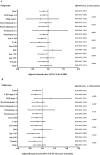Dipyridamole treatment is associated with improved renal outcome and patient survival in advanced chronic kidney disease
- PMID: 25476097
- PMCID: PMC11916813
- DOI: 10.1016/j.kjms.2014.10.002
Dipyridamole treatment is associated with improved renal outcome and patient survival in advanced chronic kidney disease
Abstract
Dipyridamole has been shown to decrease proteinuria and improve renal function progression especially in early chronic kidney disease (CKD) patients with glomerulonephropathy. A combination therapy of dipyridamole with aspirin could prevent second strokes in the general population. Whether these effects of dipyridamole are also true in advanced CKD patients and whether dipyridamole could improve renal outcomes or patient survival is unknown. We retrospectively analyzed an observational cohort of 3074 participants with CKD stage 3-5 from southern Taiwan, of whom 871 (28.3%) had received dipyridamole treatment ≥50 mg/d for ≥3 months and more than half of the observation period. The mean age was 63.6 ± 13.4 years and the mean estimated glomerular filtration rate (eGFR) was 25.5 mL/min/1.73 m(2). After inverse probability of treatment weighted adjustment by propensity score, there were no differences between the dipyridamole-treated and untreated groups. Dipyridamole treatment was associated with decreased odds for rapid eGFR decline [odds ratio, 0.755; 95% confidence interval (CI), 0.595-0.958; p = 0.007] and progression of urine protein-to-creatinine ratio (odds ratio, 0.655; 95% CI, 0.517-0.832; p = 0.002). In survival analysis, the dipyridamole-treated group was also associated with a decreased risk for end-stage renal disease (hazard ratio, 0.847; 95% CI, 0.733-0.980; p = 0.011) and all-cause mortality (hazard ratio, 0.765; 95% CI, 0.606-0.971; p = 0.001) but not for cardiovascular events. Our findings demonstrate that dipyridamole treatment is significantly associated with better renal outcomes and patient survival in patients with CKD stage 3-5. Further investigations are warranted to confirm these independent positive effects.
Keywords: Cardiovascular disease; Chronic kidney disease; Dipyridamole; End-stage renal disease; Mortality.
Copyright © 2014. Published by Elsevier Taiwan.
Figures

References
-
- Stenvinkel P.. Chronic kidney disease: a public health priority and harbinger of premature cardiovascular disease. J Intern Med. 2010; 268: 456–467. - PubMed
-
- Levey A.S., Coresh J.. Chronic kidney disease. Lancet. 2012; 379: 165–180. - PubMed
-
- Lewis E.J., Hunsicker L.G., Clarke W.R., Berl T., Pohl M.A., Lewis J.B., et al. Renoprotective effect of the angiotensin‐receptor antagonist irbesartan in patients with nephropathy due to type 2 diabetes. N Engl J Med. 2001; 345: 851–860. - PubMed
-
- Levey A.S., de Jong P.E., Coresh J., El Nahas M., Astor B.C., Matsushita K., et al. The definition, classification, and prognosis of chronic kidney disease: a KDIGO Controversies Conference report. Kidney Int. 2011; 80: 17–28. - PubMed
-
- Astor B.C., Matsushita K., Gansevoort R.T., van der Velde M., Woodward M., Levey A.S., et al. Lower estimated glomerular filtration rate and higher albuminuria are associated with mortality and end‐stage renal disease. A collaborative meta‐analysis of kidney disease population cohorts. Kidney Int. 2011; 79: 1331–1340. - PMC - PubMed
MeSH terms
Substances
LinkOut - more resources
Full Text Sources
Other Literature Sources
Medical
Research Materials
Miscellaneous

